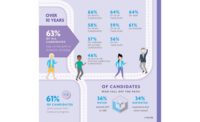NCARB’s New ‘By the Numbers’ Report Finds Increases in Licensure Exam Pass Rates, Diversity

Photo by Smolaw, Shutterstock
Data compiled for the 2024 edition of the Washington, D.C.–based National Council of Architectural Registration Boards (NCARB)’s annual NCARB by the Numbers report shows modest but encouraging growth in exam pass rates for an expanding—and increasingly diverse—pool of candidates pursuing architecture licensure.
Per NCARB, pass rates for the Architect Registration Examination (ARE) jumped 3 percent in 2023 to 58 percent—the largest increase ever for ARE 5.0 (the six-division version of the exam introduced in November 2016), with the Program & Analysis division of the exam experiencing the highest pass rate increase.
NCARB credits several initiatives implemented in recent years for the growth. Among them: the creation of free practice exams (now used by roughly 80 percent of candidates) and ESL accommodations for exam-takers. Most notable was the retiring of the rolling clock policy, a longtime roadblock to licensure—one that NCARB found disproportionately impacted women and candidates of color—that had placed a five-year expiration on passed divisions of the exam. The organization notes that the retiring of the rolling clock reinstated more than 6,600 previous expired exam divisions, which, in effect, brought 3,000 candidates closer to achieving licensure. The path, however, to licensure remains a long one: From earning a professional architecture degree to passing all divisions of the exam, it took candidates, on average, 13.3 years to achieve licensure.
Overall, the number of individuals pursuing licensure in 2023 grew 7 percent in 2023 to 37,000 candidates. The percentage of newly licensed architects saw a comparable jump of 6 percent to 3,700. According to NCARB’s data, there were 121,368 licensed architects in the United States in 2023, a 1 percent increase from the previous year.
With these metrics on the rise, so is the gender and racial diversity of candidates seeking licensure. As detailed in the 2024 NCARB by the Numbers report (the 13th such report that the organization has issued), 46 percent of candidates identify as women while 47 percent identify as persons of color. These figures mark a 4-percentage point increase over the past five years for both. Thirty-five percent of candidates who completed the exam process in 2023 are people of color, up 10 percentage points from 2019.
Of these newly licensed architects coming out of the exam process, 1 in 3 identifies as a person of color and 2 out of every 5 is a woman. Asian and Latino men are the most represented groups among licensed architects identifying as a person of color; Black men and women are the least represented. Of newly licensed architects, 9 percent are Asian women, the most of any underrepresented group. Women, on average, completed the licensure process a year faster than their male counterparts.
View the full 2024 NCARB by the Numbers report for more on the organization’s latest findings, including breakdowns of licensure statistics in all 55 U.S. member board jurisdictions, professional experience data, further insight into demographics, and more.




